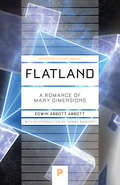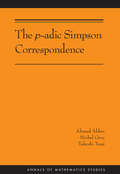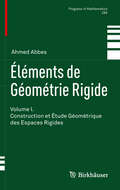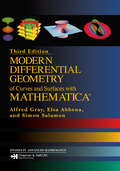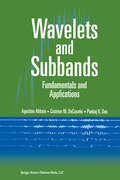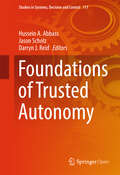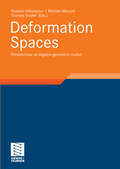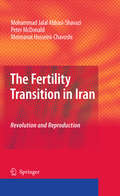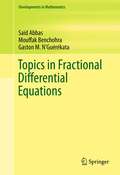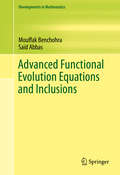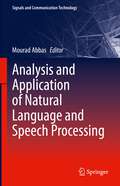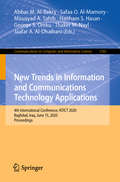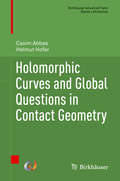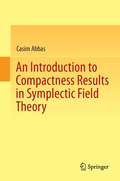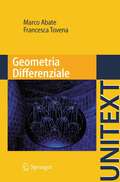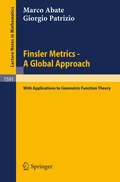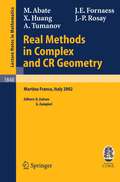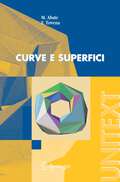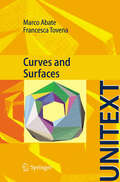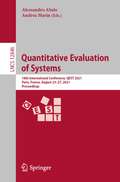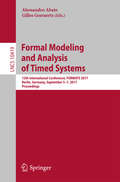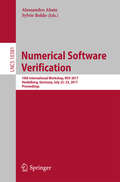- Table View
- List View
Flatland: A Romance of Many Dimensions
by Edwin Abbott Abbott Thomas BanchoffIn 1884, Edwin Abbott Abbott wrote a mathematical adventure set in a two-dimensional plane world, populated by a hierarchical society of regular geometrical figures-who think and speak and have all too human emotions. Since then Flatland has fascinated generations of readers, becoming a perennial science-fiction favorite. By imagining the contact of beings from different dimensions, the author fully exploited the power of the analogy between the limitations of humans and those of his two-dimensional characters. A first-rate fictional guide to the concept of multiple dimensions of space, the book will also appeal to those who are interested in computer graphics. This field, which literally makes higher dimensions seeable, has aroused a new interest in visualization. We can now manipulate objects in four dimensions and observe their three-dimensional slices tumbling on the computer screen. But how do we interpret these images? In his introduction, Thomas Banchoff points out that there is no better way to begin exploring the problem of understanding higher-dimensional slicing phenomena than reading this classic novel of the Victorian era.
Flatland: A Romance of Many Dimensions
by Edwin Abbott Abbott Thomas BanchoffIn 1884, Edwin Abbott Abbott wrote a mathematical adventure set in a two-dimensional plane world, populated by a hierarchical society of regular geometrical figures-who think and speak and have all too human emotions. Since then Flatland has fascinated generations of readers, becoming a perennial science-fiction favorite. By imagining the contact of beings from different dimensions, the author fully exploited the power of the analogy between the limitations of humans and those of his two-dimensional characters. A first-rate fictional guide to the concept of multiple dimensions of space, the book will also appeal to those who are interested in computer graphics. This field, which literally makes higher dimensions seeable, has aroused a new interest in visualization. We can now manipulate objects in four dimensions and observe their three-dimensional slices tumbling on the computer screen. But how do we interpret these images? In his introduction, Thomas Banchoff points out that there is no better way to begin exploring the problem of understanding higher-dimensional slicing phenomena than reading this classic novel of the Victorian era.
The p-adic Simpson Correspondence (AM-193)
by Ahmed Abbes Michel Gros Takeshi TsujiThe p-adic Simpson correspondence, recently initiated by Gerd Faltings, aims at describing all p-adic representations of the fundamental group of a proper smooth variety over a p-adic field in terms of linear algebra—namely Higgs bundles. This book undertakes a systematic development of the theory following two new approaches, one by Ahmed Abbes and Michel Gros, the other by Takeshi Tsuji. The authors mainly focus on generalized representations of the fundamental group that are p-adically close to the trivial representation.The first approach relies on a new family of period rings built from the torsor of deformations of the variety over a universal p-adic thickening defined by J. M. Fontaine. The second approach introduces a crystalline-type topos and replaces the notion of Higgs bundles with that of Higgs isocrystals. The authors show the compatibility of the two constructions and the compatibility of the correspondence with the natural cohomologies. The last part of the volume contains results of wider interest in p-adic Hodge theory. The reader will find a concise introduction to Faltings' theory of almost étale extensions and a chapter devoted to the Faltings topos. Though this topos is the general framework for Faltings' approach in p-adic Hodge theory, it remains relatively unexplored. The authors present a new approach based on a generalization of P. Deligne's covanishing topos.
The p-adic Simpson Correspondence (AM-193)
by Ahmed Abbes Michel Gros Takeshi TsujiThe p-adic Simpson correspondence, recently initiated by Gerd Faltings, aims at describing all p-adic representations of the fundamental group of a proper smooth variety over a p-adic field in terms of linear algebra—namely Higgs bundles. This book undertakes a systematic development of the theory following two new approaches, one by Ahmed Abbes and Michel Gros, the other by Takeshi Tsuji. The authors mainly focus on generalized representations of the fundamental group that are p-adically close to the trivial representation.The first approach relies on a new family of period rings built from the torsor of deformations of the variety over a universal p-adic thickening defined by J. M. Fontaine. The second approach introduces a crystalline-type topos and replaces the notion of Higgs bundles with that of Higgs isocrystals. The authors show the compatibility of the two constructions and the compatibility of the correspondence with the natural cohomologies. The last part of the volume contains results of wider interest in p-adic Hodge theory. The reader will find a concise introduction to Faltings' theory of almost étale extensions and a chapter devoted to the Faltings topos. Though this topos is the general framework for Faltings' approach in p-adic Hodge theory, it remains relatively unexplored. The authors present a new approach based on a generalization of P. Deligne's covanishing topos.
Éléments de Géométrie Rigide: Volume I. Construction et Étude Géométrique des Espaces Rigides (Progress in Mathematics #286)
by Ahmed AbbesLa géométrie rigide est devenue, au fil des ans, un outil indispensable dans un grand nombre de questions en géométrie arithmétique. Depuis ses premières fondations, posées par J. Tate en 1961, la théorie s'est développée dans des directions variées. Ce livre est le premier volume d'un traité qui expose un développement systématique de la géométrie rigide suivant l'approche de M. Raynaud, basée sur les schémas formels à éclatements admissibles près. Ce volume est consacré à la construction des espaces rigides dans une situation relative et à l'étude de leurs propriétés géométriques. L'accent est particulièrement mis sur l'étude de la topologie admissible d'un espace rigide cohérent, analogue de la topologie de Zariski d'un schéma. Parmi les sujets traités figurent l'étude des faisceaux cohérents et de leur cohomologie, le théorème de platification par éclatements admissibles qui généralise au cadre formel-rigide un théorème de Raynaud-Gruson dans le cadre algébrique, et le théorème de comparaison du type GAGA pour les faisceaux cohérents. Ce volume contient aussi de larges rappels et compléments de la théorie des schémas formels de Grothendieck. Ce traité est destiné tout autant aux étudiants ayant une bonne connaissance de la géométrie algébrique et souhaitant apprendre la géométrie rigide qu'aux experts en géométrie algébrique et en théorie des nombres comme source de références.
Modern Differential Geometry of Curves and Surfaces with Mathematica (Textbooks in Mathematics)
by Elsa Abbena Simon Salamon Alfred GrayPresenting theory while using Mathematica in a complementary way, Modern Differential Geometry of Curves and Surfaces with Mathematica, the third edition of Alfred Gray’s famous textbook, covers how to define and compute standard geometric functions using Mathematica for constructing new curves and surfaces from existing ones. Since Gray’s death, authors Abbena and Salamon have stepped in to bring the book up to date. While maintaining Gray's intuitive approach, they reorganized the material to provide a clearer division between the text and the Mathematica code and added a Mathematica notebook as an appendix to each chapter. They also address important new topics, such as quaternions. The approach of this book is at times more computational than is usual for a book on the subject. For example, Brioshi’s formula for the Gaussian curvature in terms of the first fundamental form can be too complicated for use in hand calculations, but Mathematica handles it easily, either through computations or through graphing curvature. Another part of Mathematica that can be used effectively in differential geometry is its special function library, where nonstandard spaces of constant curvature can be defined in terms of elliptic functions and then plotted. Using the techniques described in this book, readers will understand concepts geometrically, plotting curves and surfaces on a monitor and then printing them. Containing more than 300 illustrations, the book demonstrates how to use Mathematica to plot many interesting curves and surfaces. Including as many topics of the classical differential geometry and surfaces as possible, it highlights important theorems with many examples. It includes 300 miniprograms for computing and plotting various geometric objects, alleviating the drudgery of computing things such as the curvature and torsion of a curve in space.
Modern Differential Geometry of Curves and Surfaces with Mathematica (Textbooks in Mathematics)
by Elsa Abbena Simon Salamon Alfred GrayPresenting theory while using Mathematica in a complementary way, Modern Differential Geometry of Curves and Surfaces with Mathematica, the third edition of Alfred Gray’s famous textbook, covers how to define and compute standard geometric functions using Mathematica for constructing new curves and surfaces from existing ones. Since Gray’s death, authors Abbena and Salamon have stepped in to bring the book up to date. While maintaining Gray's intuitive approach, they reorganized the material to provide a clearer division between the text and the Mathematica code and added a Mathematica notebook as an appendix to each chapter. They also address important new topics, such as quaternions. The approach of this book is at times more computational than is usual for a book on the subject. For example, Brioshi’s formula for the Gaussian curvature in terms of the first fundamental form can be too complicated for use in hand calculations, but Mathematica handles it easily, either through computations or through graphing curvature. Another part of Mathematica that can be used effectively in differential geometry is its special function library, where nonstandard spaces of constant curvature can be defined in terms of elliptic functions and then plotted. Using the techniques described in this book, readers will understand concepts geometrically, plotting curves and surfaces on a monitor and then printing them. Containing more than 300 illustrations, the book demonstrates how to use Mathematica to plot many interesting curves and surfaces. Including as many topics of the classical differential geometry and surfaces as possible, it highlights important theorems with many examples. It includes 300 miniprograms for computing and plotting various geometric objects, alleviating the drudgery of computing things such as the curvature and torsion of a curve in space.
Wavelets and Subbands: Fundamentals and Applications (Applied and Numerical Harmonic Analysis)
by Agostino Abbate Casimer DeCusatis Pankaj K. DasThis book presents connections between the different aspects of wavelet and subband theory.
Foundations of Trusted Autonomy (Studies in Systems, Decision and Control #117)
by Hussein A. Abbass Jason Scholz Darryn J. ReidThis book establishes the foundations needed to realize the ultimate goals for artificial intelligence, such as autonomy and trustworthiness. Aimed at scientists, researchers, technologists, practitioners, and students, it brings together contributions offering the basics, the challenges and the state-of-the-art on trusted autonomous systems in a single volume. The book is structured in three parts, with chapters written by eminent researchers and outstanding practitioners and users in the field. The first part covers foundational artificial intelligence technologies, while the second part covers philosophical, practical and technological perspectives on trust. Lastly, the third part presents advanced topics necessary to create future trusted autonomous systems. The book augments theory with real-world applications including cyber security, defence and space.
Deformation Spaces: Perspectives on algebro-geometric moduli (Aspects of Mathematics)
by Hossein Abbaspour Matilde Marcolli Thomas TradlerThe first instances of deformation theory were given by Kodaira and Spencer for complex structures and by Gerstenhaber for associative algebras. Since then, deformation theory has been applied as a useful tool in the study of many other mathematical structures, and even today it plays an important role in many developments of modern mathematics. This volume collects a few self-contained and peer-reviewed papers by experts which present up-to-date research topics in algebraic and motivic topology, quantum field theory, algebraic geometry, noncommutative geometry and the deformation theory of Poisson algebras. They originate from activities at the Max-Planck-Institute for Mathematics and the Hausdorff Center for Mathematics in Bonn.
The Fertility Transition in Iran: Revolution and Reproduction
by Mohammad Jalal Abbasi-Shavazi Peter McDonald Meimanat Hosseini-ChavoshiConfounding all conventional wisdom, the fertility rate in the Islamic Republic of Iran fell from around 7.0 births per woman in the early 1980s to 1.9 births per woman in 2006. That this, the largest and fastest fall in fertility ever recorded, should have occurred in one of the world’s few Islamic Republics demands explanation. This book, based upon a decade of research is the first to attempt such an explanation. The book documents the progress of the fertility decline and displays its association with social and economic characteristics. It addresses an explanation of the phenomenal fall of fertility in this Islamic context by considering the relevance of standard theories of fertility transition. The book is rich in data as well as the application of different demographic methods to interpret the data. All the available national demographic data are used in addition to two major surveys conducted by the authors. Demographic description is preceded by a socio-political history of Iran in recent decades, providing a context for the demographic changes. The authors conclude with their views on the importance of specific socio-economic and political changes to the demographic transition. Their concluding arguments suggest continued low fertility in Iran.The book is recommended to not only demographers, social scientists, and gender specialists, but also to policy makers and those who are interested in social and demographic changes in Iran and other Islamic countries in the Middle East. It is also a useful reference for demography students and researchers who are interested in applying fertility theories in designing surveys and analysing data.
Topics in Fractional Differential Equations (Developments in Mathematics #27)
by Saïd Abbas Mouffak Benchohra Gaston M. N'Guérékata Topics in Fractional Differential Equations is devoted to the existence and uniqueness of solutions for various classes of Darboux problems for hyperbolic differential equations or inclusions involving the Caputo fractional derivative. Fractional calculus generalizes the integrals and derivatives to non-integer orders. During the last decade, fractional calculus was found to play a fundamental role in the modeling of a considerable number of phenomena; in particular the modeling of memory-dependent and complex media such as porous media. It has emerged as an important tool for the study of dynamical systems where classical methods reveal strong limitations. Some equations present delays which may be finite, infinite, or state-dependent. Others are subject to an impulsive effect. The above problems are studied using the fixed point approach, the method of upper and lower solution, and the Kuratowski measure of noncompactness. This book is addressed to a wide audience of specialists such as mathematicians, engineers, biologists, and physicists.
Advanced Functional Evolution Equations and Inclusions (Developments in Mathematics #39)
by Saïd Abbas Mouffak BenchohraThis book presents up-to-date results on abstract evolution equations and differential inclusions in infinite dimensional spaces. It covers equations with time delay and with impulses, and complements the existing literature in functional differential equations and inclusions. The exposition is devoted to both local and global mild solutions for some classes of functional differential evolution equations and inclusions, and other densely and non-densely defined functional differential equations and inclusions in separable Banach spaces or in Fréchet spaces. The tools used include classical fixed points theorems and the measure-of non-compactness, and each chapter concludes with a section devoted to notes and bibliographical remarks.This monograph is particularly useful for researchers and graduate students studying pure and applied mathematics, engineering, biology and all other applied sciences.
Analysis and Application of Natural Language and Speech Processing (Signals And Communication Technology Ser.)
by Mourad AbbasNew Trends in Information and Communications Technology Applications: 4th International Conference, NTICT 2020, Baghdad, Iraq, June 15, 2020, Proceedings (Communications in Computer and Information Science #1183)
by Abbas M. Al-Bakry Safaa O. Al-Mamory Mouayad A. Sahib Haitham S. Hasan George S. Oreku Thaker M. Nayl Jaafar A. Al-DhaibaniThis book constitutes refereed proceedings of the 4th International Conference on New Trends in Information and Communications Technology Applications, NTICT 2020, held on June 15, 2020. The NTICT conference was planned to take place in Baghdad on March 11-12, 2019, but due to the COVID-19 pandemic the conference has been postponed on June 15, 2020 and moved to the virtual format.The 15 full papers and 3 short papers presented were thoroughly reviewed and selected from 90 qualified submissions. The volume presents the latest research results in such areas as network protocols, overlay and other logical network structures, wireless access networks, computer vision, machine learning, artificial Intelligence, data mining, control methods.
Holomorphic Curves and Global Questions in Contact Geometry (Birkhäuser Advanced Texts Basler Lehrbücher)
by Casim Abbas Helmut HoferThis book explains the foundations of holomorphic curve theory in contact geometry. By using a particular geometric problem as a starting point the authors guide the reader into the subject. As such it ideally serves as preparation and as entry point for a deeper study of the analysis underlying symplectic field theory.An introductory chapter sets the stage explaining some of the basic notions of contact geometry and the role of holomorphic curves in the field. The authors proceed to the heart of the material providing a detailed exposition about finite energy planes and periodic orbits (chapter 4) to disk filling methods and applications (chapter 9).The material is self-contained. It includes a number of technical appendices giving the geometric analysis foundations for the main results, so that one may easily follow the discussion. Graduate students as well as researchers who want to learn the basics of this fast developing theory will highly appreciate this accessible approach taken by the authors.
An Introduction to Compactness Results in Symplectic Field Theory
by Casim AbbasThis book provides an introduction to symplectic field theory, a new and important subject which is currently being developed. The starting point of this theory are compactness results for holomorphic curves established in the last decade. The author presents a systematic introduction providing a lot of background material, much of which is scattered throughout the literature. Since the content grew out of lectures given by the author, the main aim is to provide an entry point into symplectic field theory for non-specialists and for graduate students. Extensions of certain compactness results, which are believed to be true by the specialists but have not yet been published in the literature in detail, top off the scope of this monograph.
Geometria Differenziale (UNITEXT)
by Marco Abate Francesca TovenaL'opera fornisce una introduzione alla geometria delle varietà differenziabili, illustrandone le principali proprietà e descrivendo le principali tecniche e i più importanti strumenti usati per il loro studio. Uno degli obiettivi primari dell'opera è di fungere da testo di riferimento per chi (matematici, fisici, ingegneri) usa la geometria differenziale come strumento; inoltre può essere usato come libro di testo per diversi corsi introduttivi alla geometria differenziale, concentrandosi su alcuni dei vari aspetti della teoria presentati nell'opera. Più in dettaglio, nell'opera saranno trattati i seguenti argomenti: richiami di algebra multilineare e tensoriale, spesso non presentati nei corsi standard di algebra lineare; varietà differenziali, incluso il teorema di Whitney; fibrati vettoriali, incluso il teorema di Frobenius e un'introduzione ai fibrati principali; gruppi di Lie, incluso il teorema di corrispondenza fra sottogruppi e sottoalgebre; coomologia di de Rham, inclusa la dualità di Poincaré e il teorema di de Rham; connessioni, inclusa la teoria delle geodetiche; e geometria Riemanniana, con particolare attenzione agli operatori di curvatura e inclusi teoremi di Cartan-Hadamard, Bonnet-Myers, e Synge-Weinstein. Come abitudine degli autori, il testo è scritto in modo da favorire una lettura attiva, cruciale per un buon apprendimento di argomenti matematici; inoltre è corredato da numerosi esempi svolti ed esercizi proposti.
Finsler Metrics - A Global Approach: with Applications to Geometric Function Theory (Lecture Notes in Mathematics #1591)
by Marco Abate Giorgio PatrizioComplex Finsler metrics appear naturally in complex analysis. To develop new tools in this area, the book provides a graduate-level introduction to differential geometry of complex Finsler metrics. After reviewing real Finsler geometry stressing global results, complex Finsler geometry is presented introducing connections, Kählerianity, geodesics, curvature. Finally global geometry and complex Monge-Ampère equations are discussed for Finsler manifolds with constant holomorphic curvature, which are important in geometric function theory. Following E. Cartan, S.S. Chern and S. Kobayashi, the global approach carries the full strength of hermitian geometry of vector bundles avoiding cumbersome computations, and thus fosters applications in other fields.
Real Methods in Complex and CR Geometry: Lectures given at the C.I.M.E. Summer School held in Martina Franca, Italy, June 30 - July 6, 2002 (Lecture Notes in Mathematics #1848)
by Marco Abate John Erik Fornaess Xiaojun Huang Jean-Pierre Rosay Alexander TumanovThe geometry of real submanifolds in complex manifolds and the analysis of their mappings belong to the most advanced streams of contemporary Mathematics. In this area converge the techniques of various and sophisticated mathematical fields such as P.D.E.s, boundary value problems, induced equations, analytic discs in symplectic spaces, complex dynamics. For the variety of themes and the surprisingly good interplaying of different research tools, these problems attracted the attention of some among the best mathematicians of these latest two decades. They also entered as a refined content of an advanced education. In this sense the five lectures of this volume provide an excellent cultural background while giving very deep insights of current research activity.
Curve e superfici (UNITEXT)
by M. Abate F. TovenaQuesto è un libro di testo sulla geometria differenziale di curve e superfici, adatto agli studenti universitari del secondo e terzo anno dei corsi di Laurea in Matematica, Fisica, Ingegneria e Informatica.
Curves and Surfaces (UNITEXT)
by M. Abate F. TovenaThe book provides an introduction to Differential Geometry of Curves and Surfaces. The theory of curves starts with a discussion of possible definitions of the concept of curve, proving in particular the classification of 1-dimensional manifolds. We then present the classical local theory of parametrized plane and space curves (curves in n-dimensional space are discussed in the complementary material): curvature, torsion, Frenet’s formulas and the fundamental theorem of the local theory of curves. Then, after a self-contained presentation of degree theory for continuous self-maps of the circumference, we study the global theory of plane curves, introducing winding and rotation numbers, and proving the Jordan curve theorem for curves of class C2, and Hopf theorem on the rotation number of closed simple curves. The local theory of surfaces begins with a comparison of the concept of parametrized (i.e., immersed) surface with the concept of regular (i.e., embedded) surface. We then develop the basic differential geometry of surfaces in R3: definitions, examples, differentiable maps and functions, tangent vectors (presented both as vectors tangent to curves in the surface and as derivations on germs of differentiable functions; we shall consistently use both approaches in the whole book) and orientation. Next we study the several notions of curvature on a surface, stressing both the geometrical meaning of the objects introduced and the algebraic/analytical methods needed to study them via the Gauss map, up to the proof of Gauss’ Teorema Egregium. Then we introduce vector fields on a surface (flow, first integrals, integral curves) and geodesics (definition, basic properties, geodesic curvature, and, in the complementary material, a full proof of minimizing properties of geodesics and of the Hopf-Rinow theorem for surfaces). Then we shall present a proof of the celebrated Gauss-Bonnet theorem, both in its local and in its global form, using basic properties (fully proved in the complementary material) of triangulations of surfaces. As an application, we shall prove the Poincaré-Hopf theorem on zeroes of vector fields. Finally, the last chapter will be devoted to several important results on the global theory of surfaces, like for instance the characterization of surfaces with constant Gaussian curvature, and the orientability of compact surfaces in R3.
Quantitative Evaluation of Systems: 18th International Conference, QEST 2021, Paris, France, August 23–27, 2021, Proceedings (Lecture Notes in Computer Science #12846)
by Alessandro Abate Andrea MarinThis book constitutes the proceedings of the 18th International Conference on Quantitative Evaluation Systems, QEST 2021, held in Paris, France, in August 2021.The 21 full papers and 2 short papers presented together with 2 keynote papers were carefully reviewed and selected from 47 submissions. The papers are organized in the following topics: probabilistic model checking; quantitative models and metamodels: analysis and validation; queueing systems; learning and verification; simulation; performance evaluation; abstractions and aggregations; and stochastic models.
Formal Modeling and Analysis of Timed Systems: 15th International Conference, FORMATS 2017, Berlin, Germany, September 5–7, 2017, Proceedings (Lecture Notes in Computer Science #10419)
by Alessandro Abate Gilles GeeraertsThis book constitutes the refereed proceedings of the 15th International Conference on Formal Modeling and Analysis of Timed Systems, FORMATS 2017, held in Berlin, Germany, in September 2017. The aim of FORMATS is to promote the study of fundamental and practical aspects of timed systems, and to bring together researchers from different disciplines that share interests in modelling and analysis of timed systems and, as a generalization, hybrid systems.
Numerical Software Verification: 10th International Workshop, NSV 2017, Heidelberg, Germany, July 22-23, 2017, Proceedings (Lecture Notes in Computer Science #10381)
by Alessandro Abate Sylvie BoldoThis book constitutes the proceedings of the 10th International Workshop on Numerical Software Verification, NSV 2017, held in Heidelberg, Germany, in July 2017 - colocated with the International Workshop on Formal Methods for Rigorous Systems Engineering of Cyber-Physical Systems, RISE4CPS 2017, a one-time, invited-only event.The 3 full papers presented together with 3 short papers, 2 keynote abstracts and 4 invited abstracts were carefully reviewed and selected from numerous submissions.The NSV 2017 workshop is dedicated to the development of logical and mathematical techniques for the reasoning about programmability and reliability.
